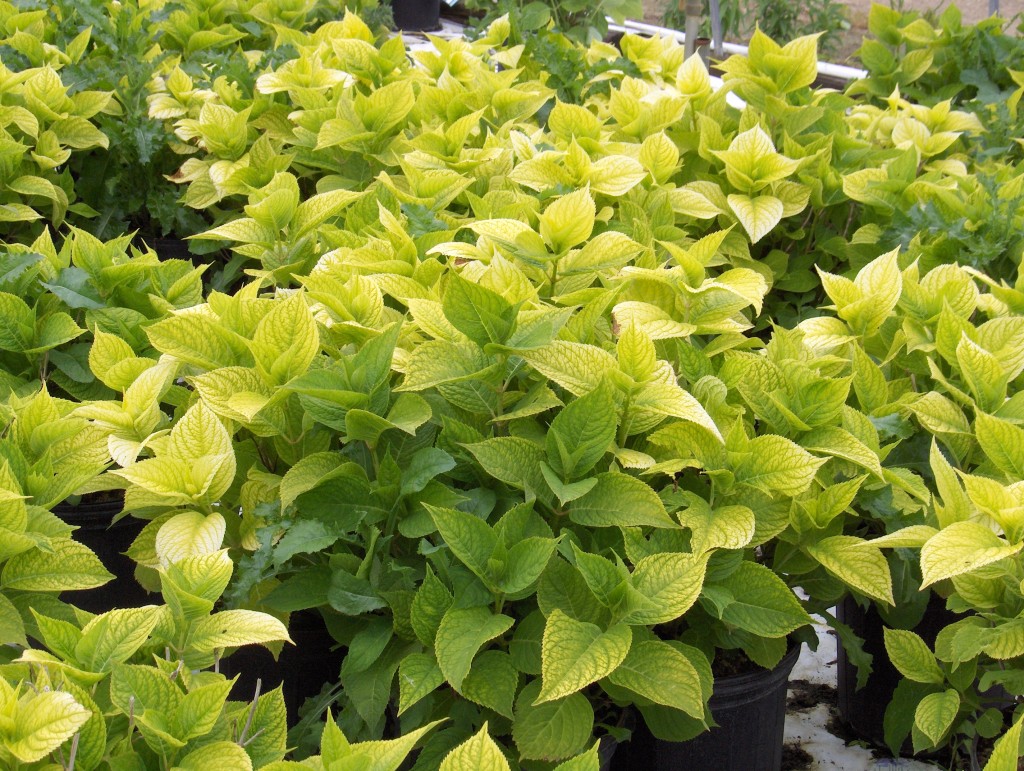
Managing Highly Alkaline Irrigation Water
Ornamental growers have long struggled with managing growing media pH. Maintaining correct growing media pH is critical for many crops especially if production time is greater than six to eight weeks. Today, numerous popular crops have difficulty absorbing iron especially when pH levels in their root zones are high. High root-zone pH can tie up micronutrients, especially in crops with a high demand for iron, such as petunias. When media pH rises excessively, micronutrients become less available and young leaves on affected plants turn chlorotic (Figure 1). Unfortunately, many growers of such crops often treat the resulting high pH symptoms by applying high concentrations of chelated iron instead of proactively managing the underlying cause the growing media with high pH levels itself.
“The most frequent cause of high root-zone pH is poor irrigation water quality, especially high total alkalinity or bicarbonate levels that can cause media pH to skyrocket over time,” said Chris Buchheit, marketing manager for Everris’s ornamental horticulture nutrition products. “Highly alkaline water can also clog injectors and drip lines with calcium carbonate deposits. Current practices to manage high alkalinity are complicated, costly and can potentially create liability issues.”
Defining Water Types
The first step in managing alkalinity in water is to determine how alkaline the water really is. Table 1 (page 34) shows how Everris defines typical water types, likely root-zone pH management issues and suggested remedies. Irrigation waters with high total alkalinity (Types 3 and 4) are very common, especially in non-coastal USA areas. Additionally, Type 2 water is widespread throughout the entire United States, and it can often benefit from some acidification depending on a grower’s crop or cropping system.
Growers who find themselves in a situation with highly alkaline irrigation water tend to fall into three groups:
Some growers don’t acidify their irrigation water and allow their crops to suffer from root-zone pH rise (iron deficiencies). They have to accept poor plant quality and the resulting lost profits.
Other growers wait until they observe obvious deficiency symptoms before they react. They ignore water alkalinity and allow growing media pH levels to rise too high, treating symptoms with higher concentrations or frequent applications of chelated micronutrients.
Still other growers test their water and devise management programs that include the following elements:
1. Consider alternate water sources with lower alkalinity levels.
2. Fight growing media pH rise by using fertilizers with higher Potential Acidity values (listed on fertilizer labels).
3. Set up acid injection systems.
4. Modify lime charge in growing media.
“All these strategies have downsides,” Buchheit said. “Growers who ignore the problem and suffer economically may do so because a simple, easy-to-implement solution isn’t available. Those who ignore the high alkalinity but treat the symptoms on selected crops must scramble to apply additives like chelated iron sprays. This makes their fertilizer programs more costly and complicated especially when they grow a variety of crops that react differently to rising pH levels in growing media. Those growers who take the trouble to test water and devise a management system still could be taking on additional costs, complexity, labor and potential risk.”
New Fertilizer Formulations
Growers need to simultaneously provide proper nutrition for their crops and manage irrigation water alkalinity (maintaining growing media pH control). Sometimes these two goals may be at odds, and meeting one objective can often compromise the other objective. For example, using fertilizers with high potential acidity to maintain an acceptable growing media pH range may be a viable option for water types with alkalinity levels below 150 ppm. The key word here is “potential,” as the acidification happens over time as plants take up these fertilizers and the roots themselves acidify the soil. The plant must actively uptake nutrients for this action to occur. These fertilizers have a higher content of ammoniacal (NH4+) and urea-based nitrogen, and their use may not always be desirable depending on crop stage and time of year as high NH4+ nitrogen can lead to lush soft growth.
Sometimes highly alkaline waters are calcium-deficient, but the only way to add calcium is to add a potentially basic fertilizer. Unfortunately using a calcium-containing fertilizer with this type of water will further contribute to rising root-zone pH levels whenever it’s applied. Acid injection causes other issues. It can be complicated to mix, corrode equipment, require the use of protective equipment, create handling and storage hazards and increase costs. Furthermore, commonly used acids such as phosphoric and sulfuric acids are not always compatible with all fertilizer formulations, often contributing significant levels of sulfur or phosphorus that can compromise nutritional programs.
To address this issue, Everris has recently developed Peters Excel pHLow, a new water-soluble fertilizer line using technology based on PekAcid, a proprietary raw material invented by its parent company (ICL) that helps manage high alkaline waters. This unique component is a pure, highly acidic, non-corrosive white crystalline raw material that contributes significant levels of phosphorous and potassium, is highly soluble, fast-dissolving, and when added in stock tank concentrate forms, phosphoric acid. It imparts active acidity properties to Everris’s products that will reduce water alkalinity at the point of injection, reducing or eliminating the need to use mineral acid.
“The new Peters Excel pHLow water-soluble fertilizer line offers growers a complete, one-bag nutrient solution and an effective tool to help manage irrigation water alkalinity that’s safer-to-use than conventional liquid acids,” Buchheit explained. “These new products are available in a variety of nutrient formulations to match crop nutrients needs: Cal-Mag, High Mag and All Purpose. At the same time, they help manage moderate to high alkalinity water, therefore helping control growing media pH.”
Buchheit says that Everris tested its new formulations on spring crops sensitive to iron toxicity marigolds and geraniums, for example to ensure that the active acidity would not cause any production problems. He says that Peters Excel pHLow-treated plants achieved very high quality grades while maintaining acceptable growing media pHs even when higher alkaline water was used.
Everris’s research and development team also tested various formulations with different nutrient contents to determine their effect on reducing excess irrigation water alkalinity levels. Regardless of nutrient content, all Peters Excel pHLow formulations have roughly equivalent active acidity of 1/3 fl. oz. of 85 percent phosphoric acid or 0.4 fl. oz. of battery acid. These predictable reductions in alkalinity while fertilizing are significant enough to be used to manage growing media pH, but not too excessive to cause problems such as low media pH:
Concentrations of 100-ppm nitrogen reduces total alkalinity by 19 ppm
Concentrations of 200-ppm nitrogen reduces total alkalinity by 40 ppm
Concentrations of 400-ppm nitrogen reduces Total Alkalinity by 72 ppm
According to Everris, products like Peters Excel pHLow can be a useful tool for growers who want an alternative to liquid acids, who use high ammoniacal nitrogen fertilizers or who are not currently doing anything to manage irrigation water alkalinity in Water Types 2, 3 and 4. For growers who are acidifying now, the use of this type of product should reduce or eliminate the amount of acid being injected. Additionally this type of treatment is well-suited for crops that require lower root-zone pH’s. Obviously if water alkalinity levels are extremely high, acid injection remains the most viable option.
“This new technology gives growers a unique opportunity to tackle high water alkalinity management, a critical factor for growing success,” Buchheit added. “Peters Excel pHlow is a reliable nutrition source that matches the needs of the plants they are growing. It’s also an effective tool to help manage moderate to high alkalinity water and it’s a safer alternative to liquid acid.”









 Video Library
Video Library 


















